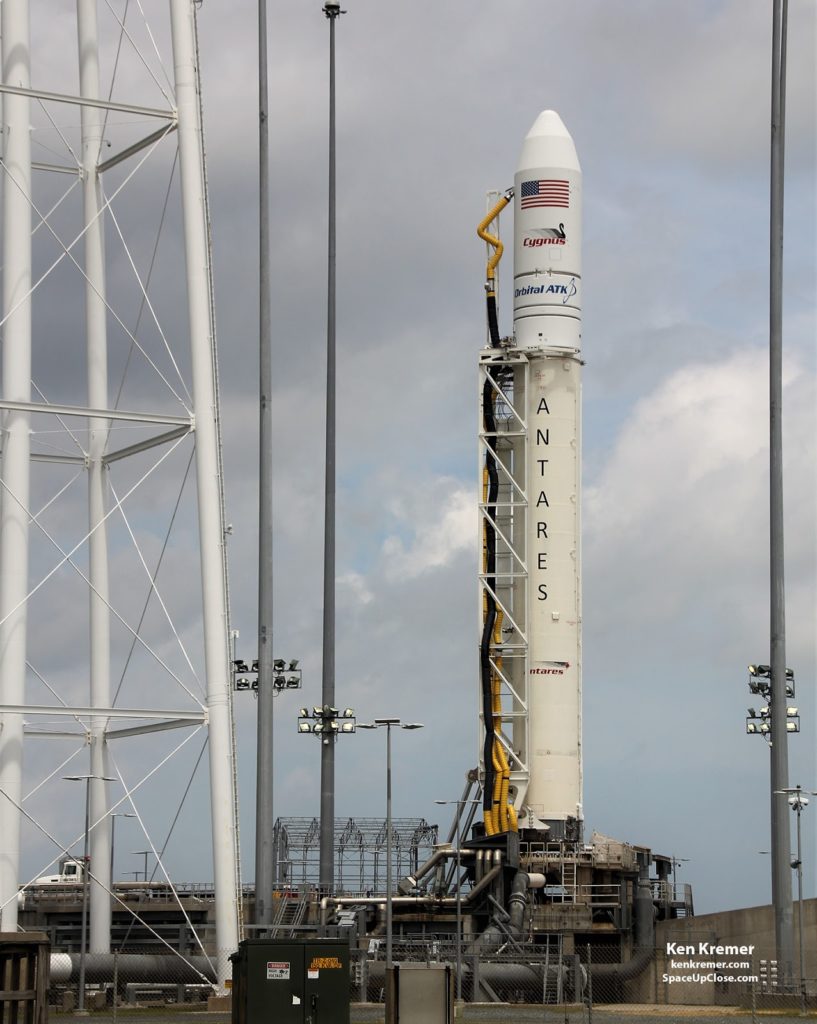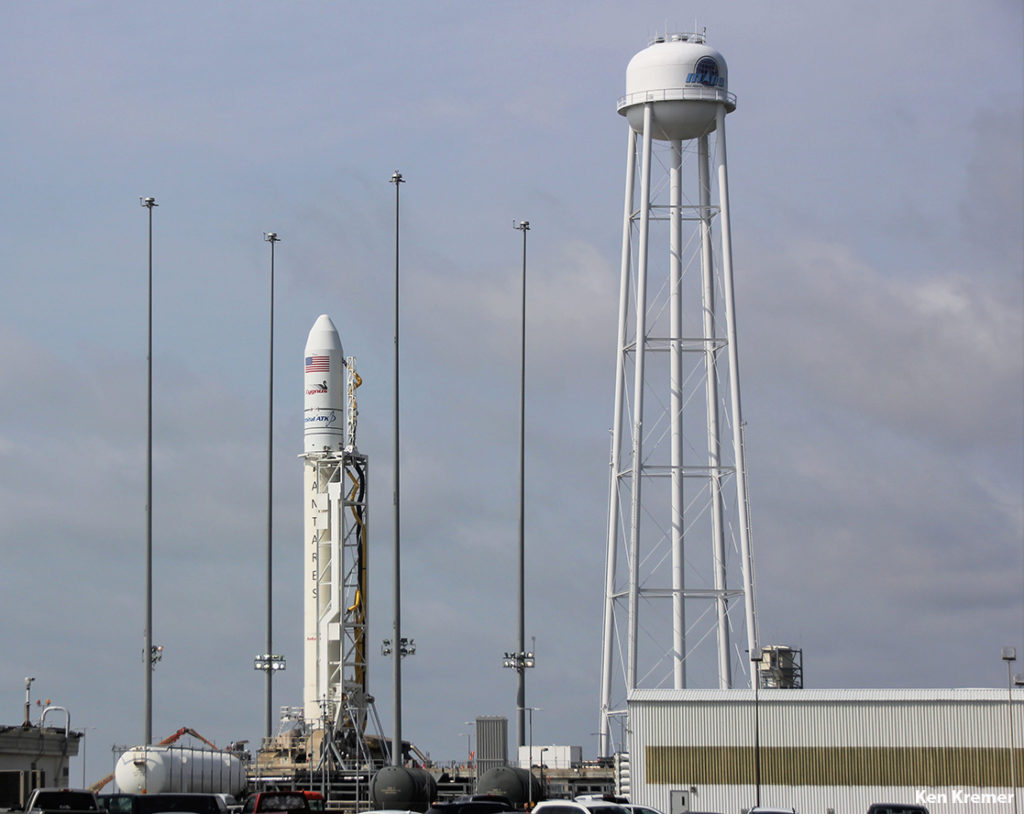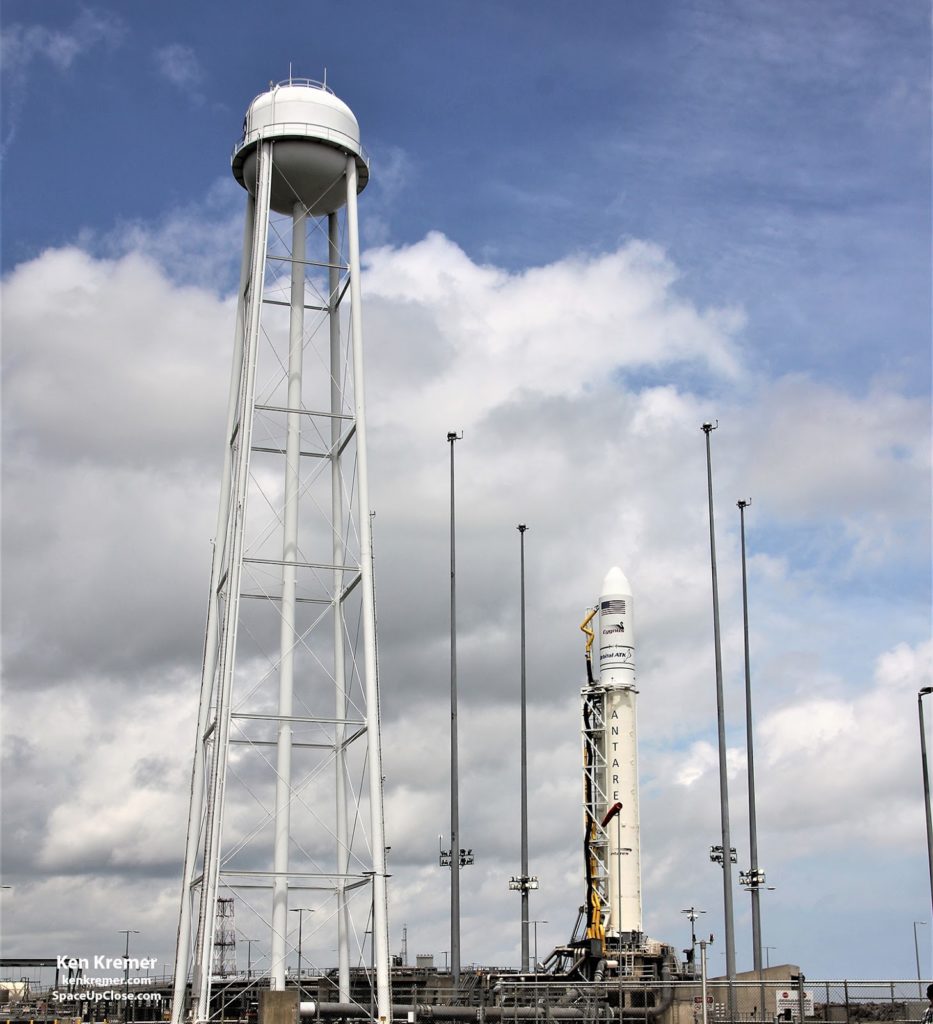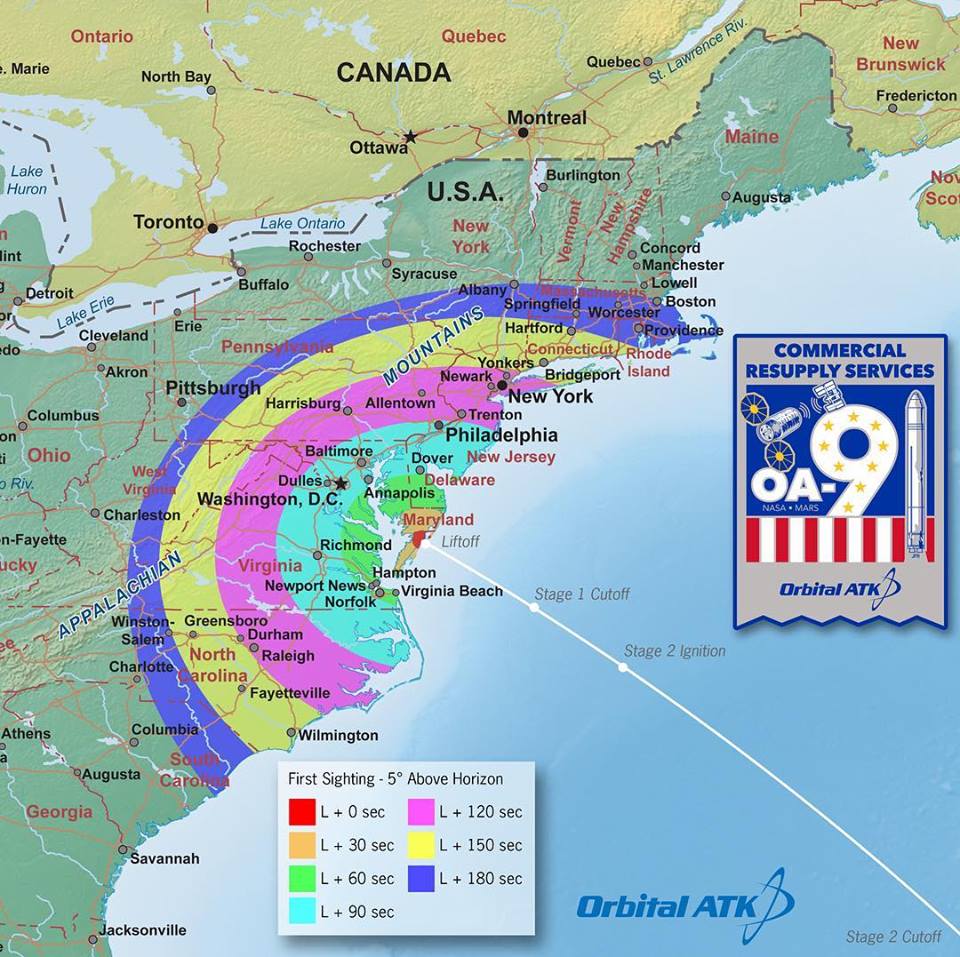 |
|||||||||
|
Orbital ATK Antares rocket goes
vertical on pad 0A at NASA’s Wallops Flight Facility for the OA-9 cargo mission launch to the ISS targeted for May 21, 2018 night launch at 4:39 a.m. EDT. Credit: Ken Kremer/SpaceUpClose.com/kenkremer.com
Ken Kremer — SpaceUpClose.com — 20 May 2018
WALLOPS FLIGHT FACILITY, VA – Orbital ATK’s Antares rocket has gone
vertical with the Cygnus cargo freighter bound for the International Space Station (ISS) and all systems are GO as the rocket is poised for a nighttime liftoff from NASA’s Wallops Flight Facility on Virginia’s Eastern shore on May 2.1
And after days of drenching rain storms at
Wallops and along virtually the entire US East Coast forced a 24 hour delay the launch is now targeted fr what could prove to be a spectacular shy show in the wee hours of Monday morning, May 21.
Liftoff of the two stage
Antares rocket carrying the Cygnus resupply spaceship is now slated for a 5-minute window that opens at 4:39 a.m. EDT May 21 from Pad 0A of Virginia Space’s Mid-Atlantic Regional Spaceport at Wallops
Check out our SpaceUpClose
photo gallery of the erected rocket captured during our pad OA tour and remote camera set up this morning
Click back as
the gallery grows.
Weather
forecasters say there is a 65-percent probability of acceptable weather for launch of Antares with Cygnus in the wee hours of Monday morning.
The main
weather concerns for Monday’s launch attempt are sky screen (essentially local visibility conditions) and disturbed weather.
A
cold front approaches from the northwest for this evening and early Monday morning. The southwesterly surface flow around the area of high pressure to the east will continue to provide a moist airmass over the Wallops region today and tonight.
The rocket was
rolled out of the Horizontal Integration Facility (HIF) late Thursday, May 17 for the 1 mile trip from the rocket assembly facility to the OA launch pad at NASA Wallops.
It was erected
into launch position Saturday evening amidst horrible weather conditions.
The rocket
measures 42.4 meters in height and 3.9 meters in diameter. The Cygnus has a pressurized volume of 27 cubic meters and is 6.39 m in height. It is loaded with 800 kg (1764 lb) of propellants.
It was erected
into launch position Saturday evening amidst horrible weather conditions.
The rocket
measures 42.4 meters in height and 3.9 meters in diameter. The Cygnus has a pressurized volume of 27 cubic meters and is 6.39 m in height. It is loaded with 800 kg (1764 lb) of propellants.
The targeted
launch date was adjusted from May 20 to May 21 after the rocket rollout was completed.
The
Cygnus vessel is jam packed with over 3.5 tons of science and supplies bound for the six person multinational crew living and working aboard the million pound orbiting outpost.
The mission,
alternatively named CRS-9 or OA-9, is Orbital ATK’s ninth contracted cargo delivery flight to the International Space Station for NASA.
On board Cygnus
are 7,400 pounds (3,350 kg) of cargo including science experiments, research gear, food, water, spare parts, crew supplies and vehicle hardware to support the Expedition 55 and 56 crews.
Cygnus will deliver
vital equipment, supplies and scientific equipment to the space station as part of Orbital ATK’s Commercial Resupply Services (CRS) contract with NASA.
The prior Cygnus cargo
freighter was successfully launched by an Antares 230 vehicle from Wallops on Nov. 11, 2017 on the OA-8 resupply mission for NASA .
Among the research
experiments on OA-9 are; the space Sextant Navigation investigation testing use of a hand-held sextant by astronauts for emergency navigation on missions in deep space as humans begin to travel farther from Earth; the Cold Atom Lab (CAL) is a new facility that will create a spot ten billion times colder than the vacuum of space, and could help us answer some of the biggest questions in physics; and Biomolecule Extraction and Sequencing Technology (BEST), an investigation to identify unknown microbial organisms on the space station and understand how humans, plants and microbes adapt to living on the station.
.
After it departs, Cygnus will also deploy a number of
cubesats from a Nanoracks supplied deployer.
The Cygnus is named the SS J.R. Thompson – after J.R. Thompson, a distinguished leader in the
aerospace industry and a member of the Orbital ATK family.
“Thompson was a distinguished leader in the
aerospace industry who helped shape the strategy and directed the operations of Orbital ATK’s predecessor company, Orbital Sciences Corporation, for nearly 25 years. Before joining Orbital, Thompson was NASA’s Deputy Administrator from 1989 to 1991,” said Orbital ATK in a statement.
The cylindrically shaped spaceship will reach orbit some
eight minutes after liftoff and begin an orbital chase
Cygnus will arrive at the ISS on May 24, three days after
launch and a carefully choreographed series of thruster firings.
“Three NASA astronauts aboard the station will
manage the spacecraft’s arrival,” said NASA. “Expedition 55 Flight Engineer Scott Tingle will grapple the spacecraft, backed by Ricky Arnold, and Drew Feustel will monitor Cygnus systems during its approach.”
“They will use the space station’s robotic
Canadarm2 to grab the spacecraft and ground controllers will command the robotic arm to rotate and install Cygnus onto the station’s Unity module.”
NASA televised prelaunch science and mission
briefings over the weekend on Saturday and Sunday.
The public is invited to watch the launch for
free from the NASA Wallops Visitor Center which opens at 1230 AM on May 21.
“Additional locations for catching the launch
are Robert Reed Park on Chincoteague Island or Beach Road spanning the area between Chincoteague and Assateague Islands. Assateague Island National Seashore/Chincoteague National Wildlife Refuge in Virginia will not be open for viewing the launch,” says NASA.
The launch could be visible to tens of
Watch for Ken’s continuing onsite coverage of Orbital ATK,
SpaceX, ULA, Boeing, Lockheed Martin and more space and mission reports direct from the Wallops Flight Facility, Kennedy Space Center and Cape Canaveral Air Force Station, Florida.
Stay tuned here for Ken’s continuing
Earth and Planetary science and human spaceflight news: www.kenkremer.com –www.spaceupclose.com – twitter @ken_kremer – ken at kenkremer.com
|




